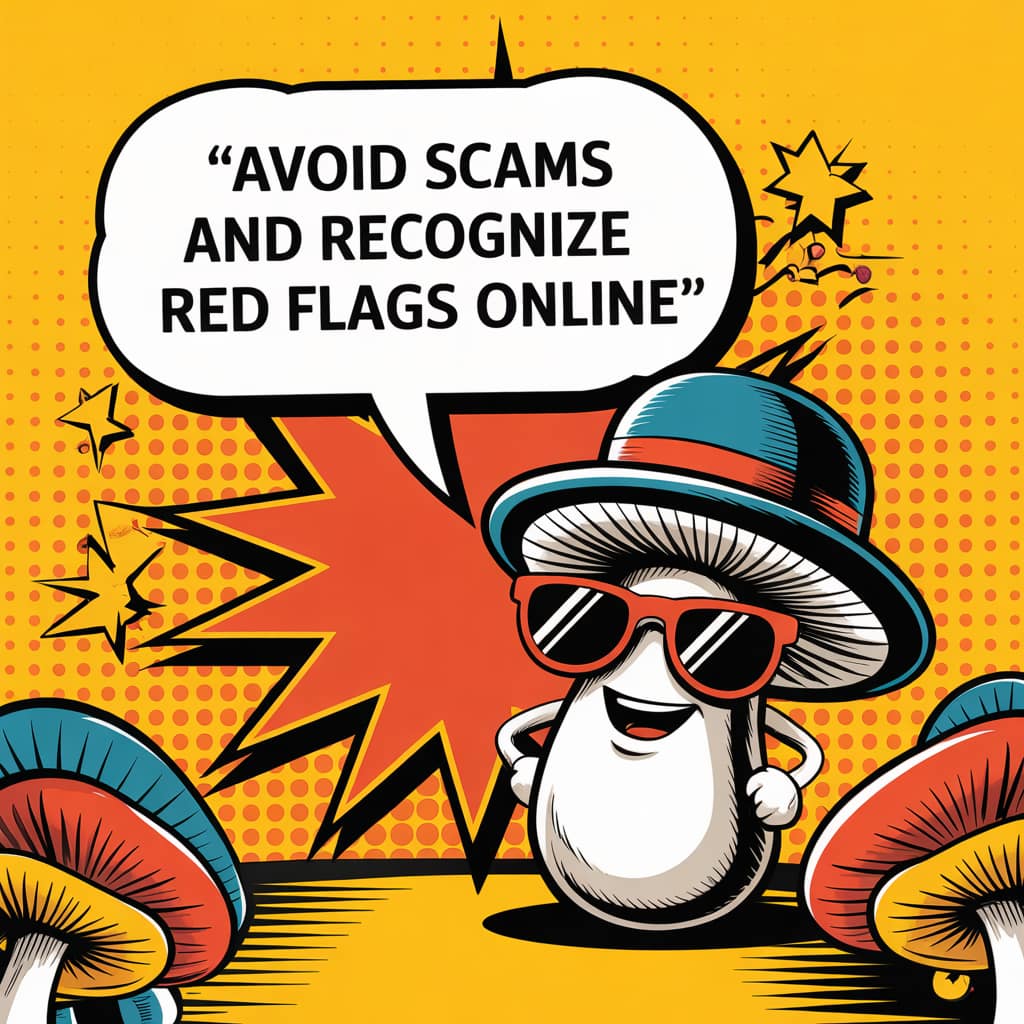
Avoid Scams And Recognize Red Flags Online
Online shopping has become a staple of modern life, revolutionizing how we buy everything from shoes to groceries. But let’s face it, with convenience comes risk. Scams and fraud are booming alongside this e-commerce wave. It’s not just about losing some cash. Your personal info might be compromised too.
Now, why are these scams getting more common? It’s partly because of the sheer volume of online transactions happening—billions every year. Plus, scammers are getting craftier and more convincing with their tricks. Advanced technologies make it easier for them to find new victims.
This article’s main goal is to make sure you know your stuff about online shopping safety. We want you to enjoy the perks without falling for traps. By the end, you’ll have the tips and tools needed to shop smarter and safer online, guarding both your wallet and your peace of mind.
Spot Phishing Emails… Don’t Bite the Bait
Phishing emails are like the pesky mosquitos of the internet world—annoying and out to get you. These emails are crafted to look legit, often mimicking trusted brands right down to the logo, but they’re just trying to steal your info.
So, how can you tell a phishing email from a real one? Look out for strange sender addresses that don’t match up with the company. Often, they’ll urge quick action—’Your account will be closed!’ or ‘Urgent: Update your details now!’—hoping to trigger panic. They might even use scare tactics about security breaches, prompting you to click on a dubious link.
To outsmart scammers, don’t rush. Pause and think before taking any action. Verify the sender by checking directly with the company, not through any links or numbers in the email. Everyone gets these emails, so you’re definitely not alone in this. Staying informed is your best defense.
Too Good to Be True? Recognize Fake Deals
Ever spotted a deal online that feels like winning the lottery? Scammers count on this excitement to trick people. They promise prices that seem impossible—because they are.
Here’s the thing: if a deal looks too fantastic, it’s probably fake. Flash sales with a countdown timer, claiming “Final Few Items Left!”, aim to rush decisions without proper research. Compare prices with different sellers and check if the supposed discount really matches up elsewhere.
Real discounts have a certain logic. Companies don’t slash prices to the point of loss. So, what should you do? Trust your instincts and use price comparison tools or apps. They’ll help you see if a deal is really a bargain or just smoke and mirrors.
Avoid falling for fake-deal traps by sticking to legitimate platforms. Signs like unusual payment requests or requests for personal information signal a scam. Remember, authenticity beats urgency any day.
Website Legitimacy? Surf Safe Digital Waters
The online market’s vastness can be overwhelming. But how do you know if the site you’re on is the real deal? Trustworthy websites usually display key security features that legitimize their operations.
First up, look for HTTPS in the web address. That little ‘s’ stands for secure and means your data is encrypted. Spotting a padlock icon next to the URL in your browser is another good sign. It shows that the site’s legit and your info’s secure.
Besides these visual cues, be wary of sites packed with pop-ups, tons of ads, or ones that ask for more personal info than usual. Genuine platforms don’t need a lengthy dossier on your life details just to sell you socks!
When in doubt, tools like WHOIS can help. They offer a history of the website, giving insights into how long the site’s been up and its registrar’s reputation. Transparency counts for a lot online, and the more open a site is about its credentials, the better.
Stick with familiar names that have good reviews and use built-in safety features in your browser to warn against dodgy sites. A little vigilance upfront can save you from costly mistakes online.
Fake Reviews and the Illusion of Credibility
In the world of online shopping, reviews are king. Scammers know this too well, often planting fake reviews to trick people into buying dodgy products.
You might wonder how to tell a real review from a dud. Watch for promotional language like ‘Best ever!’ or ‘Life-changing!’. Genuine reviews usually give balanced pros and cons and don’t sound like someone’s selling something.
Platforms like Amazon and Yelp have systems to filter out the fakes, but some still get through. Checking out multiple sources and reviews on different sites can give you a clearer picture. Comparison is your friend here.
Check review dates too. A sudden surge of glowing reviews might be an attempt to drown out negative ones. Mix in reviews that have actual photos or videos from users. These generally add a layer of authenticity.
Don’t rely on star ratings alone. Dig into the details and you’ll be safer with your purchases. Remember, a little skepticism goes a long way in dodging scams.
Safe Payment Protocols? Guard Your Transactions
Online shopping relies heavily on online payments. Picking the right payment method can mean the difference between a safe transaction and one you’ll regret.
Credit cards are usually a safe bet. They often come with fraud protection, unlike some other methods. In case something goes wrong, getting your money back is a lot easier with a credit card.
Bank transfers or debit cards? Not so much. They’re like sending cash in the mail. Once it’s gone, retrieval is nearly impossible if the transaction turns out to be fraudulent.
Exploring digital wallets like PayPal, Apple Pay, or Google Wallet is a smart move. They add an extra layer of protection, ensuring that your sensitive info isn’t shared directly with sellers.
Always keep an eye out for red flags at checkout. Sketchy payment gateways or those requesting too much personal info deserve suspicion. Sticking to trusted and familiar payment systems is crucial.
Social Media Scams? Stay Skeptical Online
Social media isn’t just for chatting with friends or creating viral dance challenges. It’s also a hotbed for scammers looking to exploit its casual vibe.
Scammers often spin their webs through ads and posts boasting unbelievable deals or exclusive offers. Always check these offers against the brand’s official pages or websites to ensure they’re legit.
Be wary of sellers with newly created profiles or those bombarding you with friend requests. Established sellers will usually have a good track record and plenty of genuine interactions.
If a brand is offering something via social media, checking their main website for announcements can confirm its authenticity. Sometimes, brands announce offers exclusively through their verified channels, not a random post.
Protect your personal information like it’s gold. Oversharing details can make you a target for scams or identity theft. Adjust your privacy settings and think twice before clicking on any links shared in these spaces.
After the Purchase? Monitor and Protect Your Accounts
Shopping done, right? Not quite. After you’re excitedly waiting for your purchase, take time for some post-purchase checks.
Monitoring your transactions regularly is key. Unexpected charges or unfamiliar sellers on your statement could mean trouble. It’s best to catch these surprises early.
Stuff updates like account statements and payment notifications to your inbox, not the spam folder. Features like two-factor authentication are free and mighty useful in keeping personal accounts safe.
Passwords are personal. Using the same one on every site? That’s like wearing one pair of shoes everywhere—it’s asking for trouble. Change passwords regularly and ensure they’re strong and unique. A password manager can simplify this.
Finally, set alerts for any activity on your accounts. Many banks offer SMS or email alerts for purchases. This keeps you in the loop and acts as an early warning system if something’s amiss.
What to Do If You’ve Been Scammed? Steps to Recovery
Realizing you’ve been scammed is not a great feeling, but action is better than panic. Swift steps can help minimize the damage and protect yourself down the line.
First, contact your bank or credit card company immediately. Many financial institutions have measures to reverse fraudulent transactions if caught in time. Reporting the scam helps them act faster.
Changing your passwords is next. This is crucial, especially if you used the same password across multiple accounts. Opt for something strong and unique while you’re at it.
File a report with local authorities or consumer protection agencies. Many countries have dedicated channels where you can report online fraud, helping prevent it from happening to someone else.
Finally, share your experience. Sharing what happened empowers others to stay safe. Head to forums or consumer review sites to warn potential victims about the scam. Recovery might be a journey, but you’re not alone. The more we talk about scams, the harder it becomes for scammers to succeed.
Smart Shopper Guide GPT
Your dynamic, eco-conscious shopping assistant for personalized, sustainable choices.
Thank you for reading, comments and shares!
Create your own website
And learn how to monetize it
Heads up! If you’re looking to join Wealthy Affiliate, make sure you sign up using my referral link to get access to my personal coaching and all WA features."







